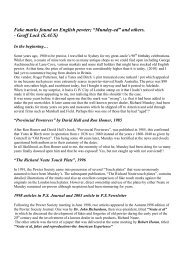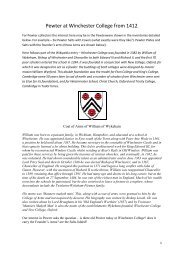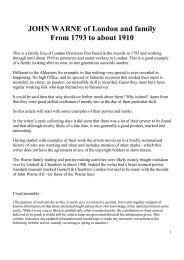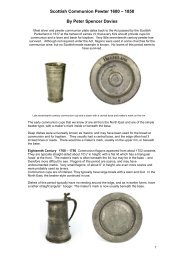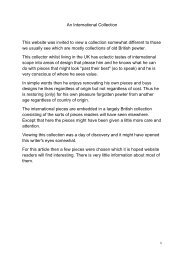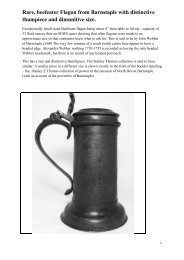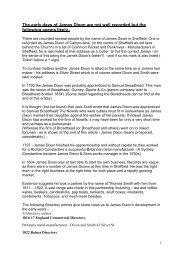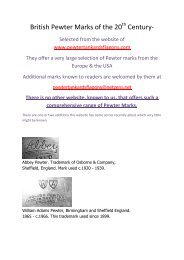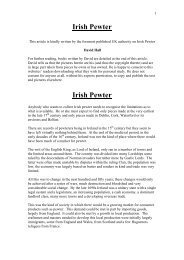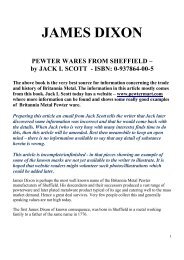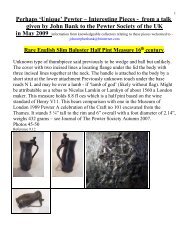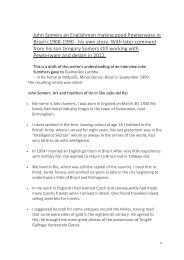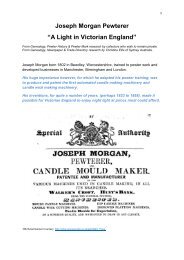Hallmarks - fake and pseudo silver marks on pewter in ... - PewterBank
Hallmarks - fake and pseudo silver marks on pewter in ... - PewterBank
Hallmarks - fake and pseudo silver marks on pewter in ... - PewterBank
Create successful ePaper yourself
Turn your PDF publications into a flip-book with our unique Google optimized e-Paper software.
end of the period a new k<strong>in</strong>d of material for plates is quoted, under the name of hard<br />
metal... It costs from 18s. to 14s. the dozen, ord<strong>in</strong>ary <strong>pewter</strong> be<strong>in</strong>g quoted at 11s. the<br />
dozen pounds. Perhaps the material is the same as that which at 1s. 4d. the pound is<br />
spoken of <strong>in</strong> the year before (1695) as the new fashi<strong>on</strong> dish... The material is probably<br />
some late discovery."<br />
What is <strong>in</strong>terest<strong>in</strong>g here is not so much the prices, but the fact that the old style <strong>pewter</strong><br />
("ord<strong>in</strong>ary <strong>pewter</strong>" accord<strong>in</strong>g to Rogers) was available al<strong>on</strong>gside the new <str<strong>on</strong>g>and</str<strong>on</strong>g> more<br />
expensive hardmetal! (See also <strong>pewter</strong>ers' trade cards <strong>in</strong> OP, such as No. 19, p. 73 of<br />
William S<str<strong>on</strong>g>and</str<strong>on</strong>g>ys <str<strong>on</strong>g>and</str<strong>on</strong>g> many others, pay<strong>in</strong>g tribute to Jaques Taud<strong>in</strong> <str<strong>on</strong>g>and</str<strong>on</strong>g> the "French<br />
<strong>pewter</strong>".)<br />
Would it then not be logical for the L<strong>on</strong>d<strong>on</strong> <strong>pewter</strong>ers to dist<strong>in</strong>guish the new, <str<strong>on</strong>g>silver</str<strong>on</strong>g>y<br />
hardmetal <strong>pewter</strong> with the modified hall<str<strong>on</strong>g>marks</str<strong>on</strong>g>, <strong>in</strong> additi<strong>on</strong> to the small crowned X we<br />
usually associate with the new alloy - how else could the customers know the<br />
difference dur<strong>in</strong>g these early days<br />
The Li<strong>on</strong> Passant was the Sterl<strong>in</strong>g Silver quality mark <str<strong>on</strong>g>and</str<strong>on</strong>g> the L<strong>on</strong>d<strong>on</strong> town mark of<br />
the leopard's head was, if crowned, referred to as the "K<strong>in</strong>g's Mark" (from the royal<br />
arms) <str<strong>on</strong>g>and</str<strong>on</strong>g> used by the Goldsmiths' with the Sterl<strong>in</strong>g Li<strong>on</strong>. Several Masters <str<strong>on</strong>g>and</str<strong>on</strong>g> senior<br />
officers of the Pewterers' Company did use these very <str<strong>on</strong>g>marks</str<strong>on</strong>g> as their Nos. 1. <str<strong>on</strong>g>and</str<strong>on</strong>g> 2. as<br />
did William Artyne <strong>in</strong> 1636. It seems, however, that the <strong>pewter</strong>ers eventually found<br />
themselves a legal loophole. A third device was added <str<strong>on</strong>g>and</str<strong>on</strong>g> (current year's) dateletter<br />
avoided or the <str<strong>on</strong>g>marks</str<strong>on</strong>g> were all or mostly <strong>in</strong>dividual <strong>in</strong>venti<strong>on</strong>s. No lawyer, even today,<br />
would accept to challenge <strong>in</strong> court such modified hall<str<strong>on</strong>g>marks</str<strong>on</strong>g>, especially as they were<br />
now always accompanied by the required touch <str<strong>on</strong>g>and</str<strong>on</strong>g> by other <str<strong>on</strong>g>marks</str<strong>on</strong>g>. That is perhaps<br />
the reas<strong>on</strong> why the Goldsmiths never aga<strong>in</strong> challenged the <strong>pewter</strong>ers<br />
Three-times Master Nicholas Kelk, Master John Stile, Upper Warden John Shorey,<br />
(f<strong>in</strong>ed Master) Thomas Shakle <str<strong>on</strong>g>and</str<strong>on</strong>g> William White (Wette) all used the above<br />
li<strong>on</strong>/leopard's head-comb<strong>in</strong>ati<strong>on</strong> for their hall<str<strong>on</strong>g>marks</str<strong>on</strong>g>' Nos.1 <str<strong>on</strong>g>and</str<strong>on</strong>g> 2 as did many others,<br />
although sometimes "scrambled". Kelk <str<strong>on</strong>g>and</str<strong>on</strong>g> Shakle used a buckle as their No. 3. (Mr<br />
Beasley <strong>in</strong>formed me that versi<strong>on</strong>s of a buckle always formed part of the arms of the<br />
Goldsmiths' Company.) Stile <str<strong>on</strong>g>and</str<strong>on</strong>g> Shorey used versi<strong>on</strong>s of a bird <str<strong>on</strong>g>and</str<strong>on</strong>g> William White a<br />
thistle as their No. 3, thus seem<strong>in</strong>gly avoid<strong>in</strong>g the renewed wrath of the mighty<br />
Goldsmiths Company.<br />
The early <str<strong>on</strong>g>and</str<strong>on</strong>g> small hall<str<strong>on</strong>g>marks</str<strong>on</strong>g> used by the <strong>pewter</strong>ers (c. 1670-1680) co<strong>in</strong>cide <strong>in</strong> size<br />
with the <str<strong>on</strong>g>silver</str<strong>on</strong>g>smiths' <str<strong>on</strong>g>marks</str<strong>on</strong>g>. The height of the crowned leopard's head-punch, for<br />
<strong>in</strong>stance, seems to average some 5.5 mm <strong>in</strong> height <strong>on</strong> both <str<strong>on</strong>g>silver</str<strong>on</strong>g> <str<strong>on</strong>g>and</str<strong>on</strong>g> <strong>pewter</strong> items of<br />
this period. The fact that these early sets of <strong>pewter</strong>ers' four hall<str<strong>on</strong>g>marks</str<strong>on</strong>g> all had<br />
<strong>in</strong>dividual shield-outl<strong>in</strong>e suggests that they were purchased as an off-the-shelf item<br />
from die-makers, such as Richard Hall, who also supplied the <str<strong>on</strong>g>silver</str<strong>on</strong>g>smiths with their<br />
punches. Had these <strong>pewter</strong>ers especially ordered complete sets from a die-maker, the<br />
shield-outl<strong>in</strong>e would logically be the same for each mark <strong>in</strong> a set. Kelk, Stile, Shakle<br />
<str<strong>on</strong>g>and</str<strong>on</strong>g> William White (menti<strong>on</strong>ed above) all seem to have identical dies for their No. 2<br />
leopard's head, crowned (see illustrati<strong>on</strong>s). These dies have the same elaborate<br />
outl<strong>in</strong>e, follow<strong>in</strong>g the outl<strong>in</strong>e of both crown <str<strong>on</strong>g>and</str<strong>on</strong>g> head. The crowns all have three<br />
po<strong>in</strong>ted "ears" which with wear give a stylised wolf-impressi<strong>on</strong>. The ch<strong>in</strong>s of the li<strong>on</strong>s



